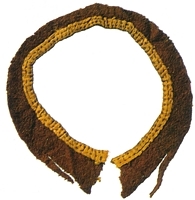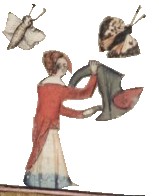These are notes for a class on mending at Skraeling Althing’s Practicum 2018.
Why should we learn about mending and patching? For me, it is mainly because I have been doing recreation long enough that my clothing is starting to show distinctive signs of wear. Worn hems, moth holes, burn marks from cooking fire sparks, tears, and possibly even clothing that has shrunk in my closet. But it is also about the medieval aesthetic. I prefer clothes that look properly worn, not costumes. To me, outfits that look too fresh just don’t look right. As a medieval woman, cloth is precious to me because it takes so long to make. I won’t throw it out simply because it needs a little repair. Instead, I will wear my dress until it is absolutely threadbare, patching and mending to keep it in use as long as possible.
Medieval Tailor’s Assistant: Common Garments 1100-1480, by Sarah Thursfeld (The Crowood Press, 2001), has useful information on repairs. According to Thursfeld, patching was more common than darning. She says that matching the fabric weight was more important than matching the colour, and that patches were applied to the right side of the clothing. Patches should have their grain aligned with the grain of the item being repaired. In the case of light fabrics, the raw edges of the patch should be turned under and the patch stitched in place. Then turn over the item, trim back the raw edges until your hole matches the square of the patch, snip into the corners, and then turn under and hem to the patch. For heavier-weight fabrics, there is no need to make a hem allowance. Thursfeld notes that the most common item needing repair was split hose. For them, match the patch to the grain, then darn the hose to the patch. Be sure to do it unevenly, as otherwise the hose are likely to split again. Finally, trim the patch close to the darning and leave the edges raw.
Rosalie’s Medieval Woman (https://rosaliegilbert.com/sewingtechniques.html) has an example of a neckband with a silk strip sewn to the inside of the neck of a high-grade woolen garment. A band like this one would provide extra re-enforcing where wear and tear is likely to occur. The opening reinforcing is made from a narrow silk strip. It is dated between 1325 to 1350.
It is possible that this garment or others like it had similar bands at the ends of the sleeves to reinforce the edges which were subject to the most wear.

Rosalie also offers advice on worn ems and cuffs. She notes that it was not uncommon for a woman to cut the hem of her gown off when it was too ragged and re-sew it a little shorter or to replace it with a strip of new fabric.
She gives the example of a picture from the Romance of Alexander showing a woman catching butterflies who appears to have rehemmed her dress. This is not purely decoration. Toni Mount’s book, Everyday Life in Medieval London, explains that in 1320, the household wardrobe accounts of Edward II’s wife Queen Isabella herself had garments re-hemmed to prolong the wear of them and save the cost of new gowns.

(https://rosaliegilbert.com/clothingcare.html)
This may also be an example of a dress or hem guard, something which shows up fairly commonly in the Renaissance. A guard is a wide band of less expensive fabric which could be added to over and underskirts to take the wear of weather, dirt, and dragging on the ground. These could be removed and replaced when soiled or worn out, preserving the more expensive skirts
John Frey’s blog (http://matsukazesewing.blogspot.ca/p/repairs-on-extant-medieval-garments.html) has an excellent article listing many repairs on extant medieval garments.
Herjolfsnes 43. Much patched, including a large patch on the lower edge suggesting a sword being worn with it. S1
Uppsala Gown – the front skirt has two nearly invisible patches in the front skirt—suggesting it had been stepped on. S1
The Moy Gown was patched and there are holes at stress points in the garment. S1 There was also a small patch covering (re-enforcing?) the point of the back gores. S5
Dava Moor, Cromdale, Morayshire. Presumably in Scotland. May be post period. – Unknown dating. Clothes are ragged in the extreme and contain at least 29 different cloths (fabrics?). S2
Shetland. (NA 249.) – Felt skullcap with two tears roughly mended with thick 2-ply brown wool, and a hole near the edge roughly patched with two pieces of cloth. S2
Dungiven Costume – All the garments were tattered and had been lined with patches. S3 The doublet was lined with patches. The trius were a mass of patches by the time of burial, something like six layers deep in places. S6
Skjoldehamn Find – The shirt was heavily patched on (as worn) the underside of the right sleeve; underarm (towards the front) of the right sleeve; the right side in the area of the hip covering front and back side (this one looks like it’s been patched a couple of times—there’s definitely two separate patches, one overlapping the other); a large one on the left side, more towards the front and slightly higher than the right side; just above it there is another patch; there is one at the inside intersection of the other two left patches; there are two other patches in the front and underarm of the left side. S4 p.83-84
- All the patches are irregular in shape, I believe that most of them used a whipstitch (wool thread—almost looks white), but one or two may have used back/running stitch. I believe that most of the patches have been turned under, but one in particular (right underarm) looks frayed on one edge. Most of them as well are on the outside of the material, but the three small patches near/on the left arm are actually done from the wrong side of the material—on one you can actually see the outline of the patch in a way that suggests that it was fastened with a whipstitch. S4 p.82
- In light of some new information, I found out that all of the patches were roughly overcast with a variety of yarn types, Z2S being the most common. On some at least, an overcast stitch was used to stitch the raw edge of the hole to the patch it’self, making the repair more solid. S4 translated by Asfridhr
Bernuthsfeld Tunic – A bog find dating to the 7th century in Germany, it was found at the beginning of the 20thcentury, and is composed of 45 pieces of different wool fabrics, sewn together in a patchwork. S7.
- Personally I don’t believe that it was made as a patchwork to begin with, and is the result of extensive repairs—perhaps over a couple of generations. Looking at a colour image of the tunic, I agree with myself–several of the pieces are attached slantwise and are quite obviously layered.

 |
| Schlabow2376, Bernuthsfeld Tunic. Front. |
 |
| Schlabow2376, Bernuthsfeld Tunic. Back. |
Robe of St. Francis of Assisi

Lendbreen Tunic (250-340AD) – Two patches, in the same area. The first, square patch was placed on the wrong side, and the edges of the hole (probably trimmed) were whipstitched down. The second patch was lain over the first, on the inside, sewn down with a running stitch (probably along the edge of the hole), and had the edges whipstiched down. (S9) The second patch is of slightly different material, and sewn using different thread than the first one. There is also a seam repair on the right sleeve. Whipstitch. (S9)
S1) http://users.skynet.be/bister/Passion/Fichiers/14th%20century%20garments.pdf Some mentions of repairs
S2) Early Scottish Textiles. http://archaeologydataservice.ac.uk/catalogue/adsdata/arch-352-1/dissemination/pdf/vol_086/86_001_029.pdf
S3) The Dungiven Costume http://www.jstor.org/discover/10.2307/20627382?uid=3739512&uid=13674576&uid=2&uid=3&uid=3739256&uid=60&sid=47698868231857
S4) Nye tanker om Skjoldehamnfunnet.http://www.ceilingpress.com/Resources/Nye%20tanker%20om%20Skjoldehamnfunnet.pdf
S5) Reconstruction of the Moy Bog Gown. http://www.personal.utulsa.edu/~marc-carlson/cloth/moy3.html
S6) The Dungiven Costume, Reconstructing History article
S7) The conservation of an early mediaeval patchwork-style tunic. This is the paper information.
http://www.bcin.ca/Interface/openbcin.cgi?submit=submit&Chinkey=181367
S8) The Robe of St. Francis of Assisi. There is a photo, although I believe the white patches may be modern. http://blog.beliefnet.com/deaconsbench/2007/10/the-robe.html
S9) Lendbreen Tunic. https://www.academia.edu/4372500/Out_of_the_Norwegian_glaciers_Lendbreen-a_tunic_from_the_early_first_millennium_AD
Note: This piece is under construction, and will occasionally be updated.
4-16-15: Edited Bernuthsfeld comment. Added Bernuthsfeld and Assisi pictures.
© John Frey, 2014. The Author of this work retains full copyright for this material. Permission is granted to make and distribute verbatim copies of this document for non-commercial private research or educational purposes provided the copyright notice and this permission notice are preserved on all copies.
Clothes aren’t the only things that need mending. This article has an amusing description of repairing the seams on woven socks. https://diehandmaid.wordpress.com/2016/04/03/sonniges-saisonstart-struempfestopfen/
Woven into the Earth: Textiles from Norse Greenland by Else Ostergard has examples of patches and piecing. The hood on p. 207 shows two piecings on the bottom of the hood, and there is a patch on the right side. A cap on p 219 has a patch below the crown (and the cap is made in two pieces). The cap on p 220 is made of four pieces of different cloth, plus the crown. The tunic on p 175 has a left sleeve that is pieced and patched. The tunic on p 169 has a gusset that has been pieced.
The blog Medieval silkwork (http://www.medievalsilkwork.com/2013/10/mending-old-shirt.html) has a darning technique that is plausible but may be post-period. She weaves a darn right into the old cloth, using pins to hold the warp threads in place. She only attaches by sewing in on the weft edges, but you could also put a stitch in above each pin. This is very good for places where you don’t want the bulk of patches, such as under armpits.
Similar darns can be used on woven or knitted socks, though I don’t bother with the pins. Instead, I use a darning egg and stitch right into the cloth to form a warp, and then weave a weft as I work back. Naalbinding socks can be repaired simply by naalbinding a new section in the worn or torn spot.
A new book, Clothing the Past: Surviving Garments from Early Medieval to Early Modern Western Europe, by Elizabeth Coatsworth and Gail Owen-Crocker, has reference to patches and repairs according to Google Books, but it is an expensive investment so I don’t yet own a copy to provide more details.
Read Full Post »





